A wide back has always been and will be the calling card of not only a bodybuilder but any athlete. An athletic physique is determined more by the V-shape of the torso than by the volume of the biceps. Therefore, it is necessary to treat the development of the back thoroughly from the very beginning of training, realizing which of the exercises affects the development of thickness and which of the width of this muscle group. Below are the best exercises for the gym.
How to pump up your back in the gym: features of training for men
- At the beginning of training, do not chase too much weight.the fact that the working weight for the back is large, the quality of the form and the growth rate will not increase in any way.
- To start bring your technology to perfectionwork 12-14 repetitions for 3 sets.
- Back muscles It is enough to train once a weekwhile the effectiveness will not decrease, but on the contrary, the muscles will have time to recover qualitatively and continue to grow.
- After a month, you need to add weight and work in the following mode: 8-12 repetitions, 4 sets. At the same time, the number of exercises and the complexity of the technique should increase.
Top 7 best back exercises in the gym
1. Pull block behind the head
The exercise develops the width of the back and is performed in a special block simulator. To do this, you need to install a wide handle for traction from the upper block.
- While standing, grab the handle with a wide grip – wider than shoulder width.
- Sit on the seat, and place your thighs under the special bolsters for support, if they are provided for by the design.
- Hold the handle above your head with your arms straight.
- Exhale, bending your elbows, and place the handle behind your head. to the level of the back of the head, but not below the neck. At the lowest point, bring your shoulder blades together. The pull should be performed using the efforts of the back muscles, not the arms.
- As you inhale, smoothly return your arms up to a position with straight elbows.

- Do not touch, much less hit, the cervical vertebrae with the handle.
- Perform the downward movement a little faster, but not sharply, and upward more slowly – without jerking the shoulder joints.
- Perform the exercise concentrated; inertia, that is, rocking, is inappropriate here.
2. Wide-grip rows
The row is performed in the same machine as the previous one, only the row is changed to the other side – in front of you.
- Grab the bar with a wide grip while standing.
- Lower your pelvis onto the seat, extending your arms straight with the bar above your head. Place your thighs under special rollers.
- Tilt your body slightly at an angle back, but don’t bend at the waist.
- As you exhale, bending your elbows, pull the bar toward your collarbones, rounding your chest and bringing your shoulder blades closer together. The movement is performed using the strength of the back.
- As you inhale, slowly straighten your elbows, maintaining the tilt of your body.
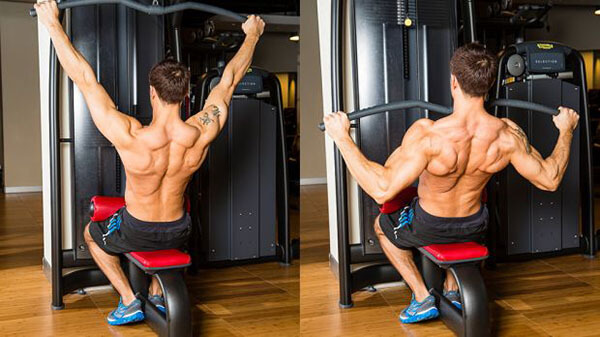
- Do not jerk either above or below.
- Control your lower back and the entire spine as a whole, try to bend only the thoracic region.
Read more about lat pulldowns to the chest and behind the head →
3. Reverse Grip Rows
This exercise is aimed at developing the thickness of the back muscles. With this technique, the biceps are more involved in the work, so make sure that it is not your arms that take most of the load on yourself, but your back.
- While standing, grab a wide bar with a reverse grip from below, the width of your shoulder joints.
- Lower your pelvis onto the seat, lock your hips, and tilt your body back slightly, as in the previous version.
- With an exhalation, pull the bar to the upper clavicular part of the chest, additionally arching the chest with a “wheel”.
- As you inhale, slowly straighten your arms, fully extending your elbows.
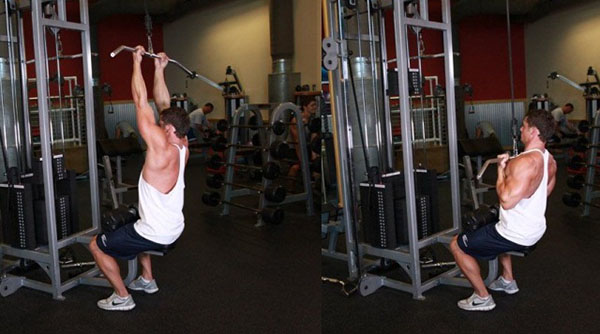
- Maintain your body tilt.
- Do not reach for the bar with your entire torso.
4. Row of a horizontal block to the belt
Another exercise performed on a block machine that develops the thickness of the back muscles.
- Sit on the seat and rest your feet in front of you on special supports, slightly bend your knees.
- Grab the pre-positioned row handle with a close grip, then pull the block towards you, straightening your torso, and keeping your spine vertical.
- Keep your elbows straight.
- As you exhale, stretch the handle toward your stomach, bringing your elbows as close to your body as possible. When bringing the handle closer to your stomach, bend your thoracic region in order to maximally involve the back muscles in the work, bring your shoulder blades closer to each other.
- As you inhale, slowly straighten your elbows without changing the position of your torso and knees.
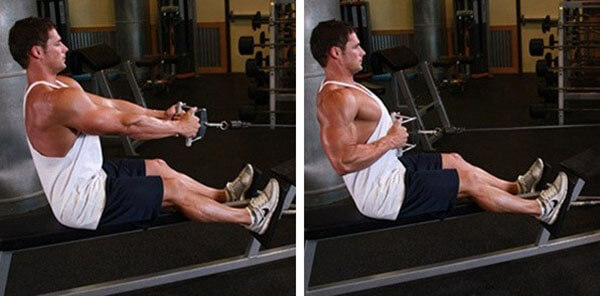
In this exercise, it is important to bend the chest when pulling to the waist, otherwise the arm muscles will be more stressed than the back.
Read more about rowing →
5. Pull of the lower block of the crossover to the belt
This exercise replaces pulling a barbell to the belt, relieves tension from the joints of the arms and spine, therefore it is safer than a barbell and no less effective.
- Place the straight handle on the lower block of the crossover, place your palms with a medium grip – shoulder-width apart and straighten your back, holding the handle with straight hands.
- Take a few steps back, tilt your body, keep your arms straight, and keep the cable taut.
- As you exhale, pull the handle toward your lower abdomen, bringing your shoulder blades together.
- As you inhale, slowly straighten your arms without changing the position of your torso.
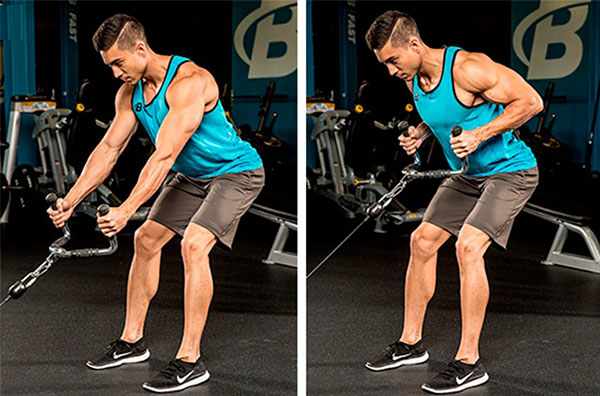
- Do not round your back under any circumstances, despite the fact that the exercise is less traumatic than the barbell option.
- When performing the approach, do not swing your torso, keep your body in one position.
6. Linkage
A back muscle machine in which the load is varied by adding or removing barbell plates. The same weight must be placed on each side.
- Set the seat of the exercise machine at the desired height so that your stomach rests against a special pillow, which should end below the thoracic region, approximately at the ribs.
- Grab the vertical handles of the machine, take the starting position with a straight back and straight arms. Straighten your shoulders, do not round your back. From now on, do not lower the levers to the lowest point.
- As you exhale, pull the handles towards your torso, further arching your thoracic region, but without lifting your stomach from the exercise pad.
- As you inhale, slowly straighten your elbows. Lower the handles to the starting position, slightly pulling the shoulder joint forward, and stretching the back muscles.
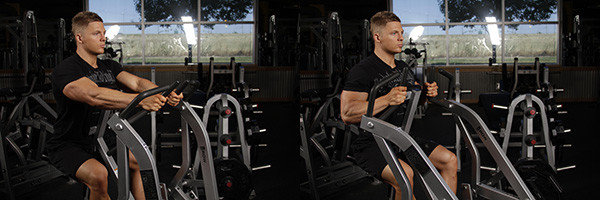
- There should be no jerking or swinging in this movement.
- Perform the technique in a concentrated manner, working with your back muscles, not your arms.
Read more about rowing in a lever machine →
7. T-bar row in the simulator
This simulator provides two options for traction: narrow and wide grip, so it is necessary to determine the technique taking into account the previous exercises, so that the number of exercises with a narrow and wide grip is the same. The exercise is also a safer option for rowing a barbell to the belt, as it provides support and reduces the risk of spinal injury.
- Load the machine with plates of the required weight.
- Place your feet on the special supports of the exercise machine, and place your stomach on a special support for the abdomen, slightly tilting your body.
- Grab the handles of the machine depending on the grip you need and lift the lever off the floor.
- As you exhale, pull your arms towards your body, trying to bring your shoulder blades closer together, and pause at the top point.
- As you inhale, slowly lower your arms, fully straightening your elbows.
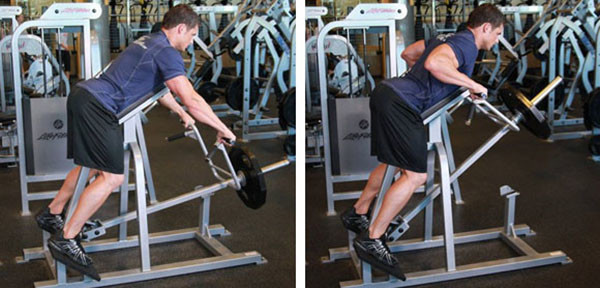
In this exercise, it is important to perform the full amplitude and not lower the weight of the machine sharply down, as you can easily injure the shoulder joint.
Training program for the back day in the gym
Beginners should first combine not one muscle group, but at least two, in one workout. At this stage, it is better to combine the back muscles and biceps of the shoulder. The workout looks like this:
- Pull-down of the upper block behind the head 3-4 x 12-14.
- Wide grip front row 3-4 x 12-14.
- Lever rod 3-4 x 12-14.
- Horizontal block pull to the belt 3-4 x 12-14.
- Standing barbell curl 3-4 x 12-14. Biceps.
- Curling arms with dumbbells with supination 3-4 x 12-14.
Conclusion
You should not develop your back with daily pull-ups or frequent training on exercise machines, as this can lead to overworking of the back rather than its strength, and this will have almost no effect on the volume and shape. If the load seems small, over time, start training with pull-ups for the maximum number of repetitions for 3-4 sets, and only then proceed to exercise machines and equipment. Train your back consciously, increase the load gradually and get proper rest – this is the only way to achieve good results; it is also important to monitor your diet during the period of weight gain.
And also read:
How to do pull-ups for your back →
Exercises for pumping up the back →

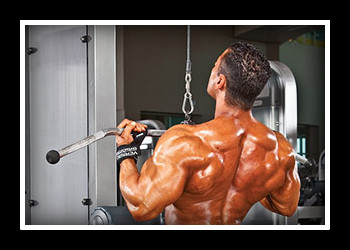
Leave a Comment